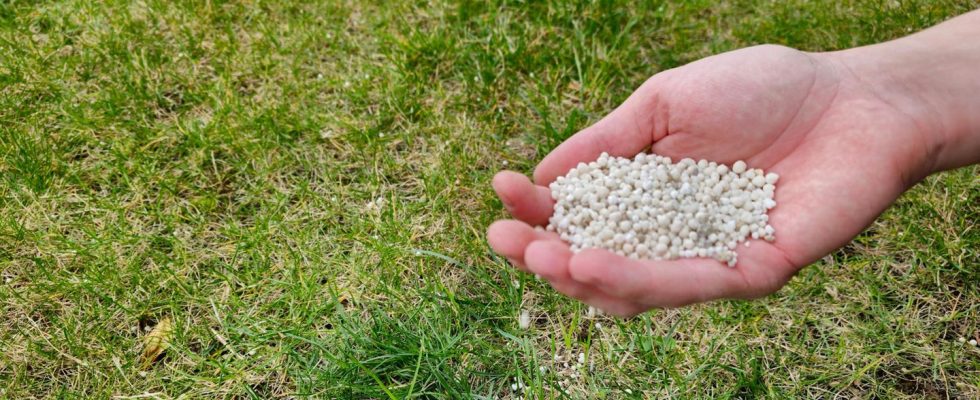Gardening tips
Fertilize the lawn in spring: otherwise the lush green will fail
If you want your lawn to stay green and healthy, it needs care. At the top of the care list: fertilizing the lawn. Especially in spring, the greenery needs a strong booster in order to grow vigorously until summer.
© vitapix / Getty Images
If you want to proudly show off your lush green lawn in summer, you have a lot to do in spring. Which care levels are important and why fertilizing the lawn is crucial.
Lawn care is a science. This can be seen from the fact that in sports greenkeepers are paid to ensure that not a single blade of the sacred lawn is bent and that it is permanently lush green in the sap. Now you can hardly compare the short grass carpets in football stadiums or other sports facilities with the small green behind the house or in the allotment garden. But with a little care, the playing area for children and children can also be trimmed into an attractive lawn. Fertilizer is an important building block on the way there. Here you can find out why fertilizing the lawn is particularly important in spring, which nutrients the blades particularly like and how to apply the fertilizer correctly.
Fertilizing your lawn: The right time
Strictly speaking, there are several correct and important times when fertilizing your lawn. In order for the greenery to remain resilient and to assert itself against weeds, it should be regularly supplied with nutrients throughout the year. It starts in March/April, when the stalks need a strong boost of energy after a long winter with little sunlight. You then add a small fertilizer snack about three months later in the summer. The lawn receives the last nutrient booster in autumn, at the latest at the end of October.
Which fertilizer is the right one?
Here, too, there is no one right answer. In order to support the stalks in the important time of early summer, i.e. over a longer period of time, you should ideally use one in spring Long-term fertilizer. It contains all the important nutrients, including potassium, which provides the meadow with important defenses. In addition, it helps the tender young stalks to take off after new or re-sowing. Make sure that the slow-release fertilizer contains as little phosphate and no nitrate as possible. Both salts are not needed at all or only in small quantities by the roots and also pollute the already stressed groundwater.
While it is important in spring which fertilizer you apply to the lawn, summer fertilization is more about waiting for the right moment. Rule of thumb: Never fertilize in the midday heat. Instead, opt for the evening hours and when the weather is as humid as possible. Why? When the soil is bone dry, the irrigation water (which dissolves the nutrients) evaporates so quickly that the roots have to process nutrients that are too concentrated, which can harm them. And that’s exactly why fans of lush green go for organic or organic-mineral lawn fertilizer. On the one hand, they are easier to dose. Secondly, due to the lower proportion of minerals, there is hardly any risk of over-fertilizing or damaging the roots of the lawn. Third point: Organic fertilizers are harmless to insects and all other small and large garden animals.
In autumn, the lawn needs a lot of food in order to be able to permanently defend itself against the low temperatures of winter. As a rule, have special Fall lawn fertilizer therefore a fairly high potassium content.
Fertilizing your lawn in spring: Tips for the ideal application
If you work with organic fertilizer, you can supply normal soil with nutrients from the beginning of March. It is best to apply mineral fertilizers about a month later. The reason: Organic fertilizers release nutrients much more slowly, but more evenly.
That’s how it works:
- Clear the lawn of leaves and leaf residue.
- Trim the lawn to a length of about four centimeters.
- Depending on the condition of the lawn, aerate or scarify.
- Fertilizer by hand or with one Spreader truck Spread over the surface according to the instructions on the package. (Important: After scarifying, the soil needs significantly more fertilizer)
- Water the lawn generously.
Fertilizing the lawn: What else is important
In order to fertilize the lawn evenly, experienced greenkeepers recommend using one Spreader truck to work. It is important that you tile across the meadow in a structured manner and not in a freestyle manner. It’s best to go one lane at a time and, if possible, with no gaps in between. Fertilizing by hand is a little more demanding. However, swinging your arm with your half-open hand should be practiced; otherwise, when fertilizing by hand there is a risk of showering the lawn with too many nutrients. By the way, fertilizers from well-known manufacturers are safe for dogs and small children. Problematic ingredients such as castor bean meal, which used to be contained in many fertilizers, no longer end up in their nutrient mixtures for a long time. Immediately after fertilizing (and watering), the meadow is free to kick and run around again.
Sources:Plantura garden magazine, My beautiful garden
You might also be interested in:
This article contains so-called affiliate links. Further information are available here.


